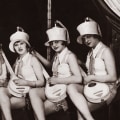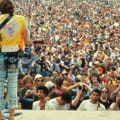The most common forms of popular culture are movies, music, television, video games, sports, entertainment, news, fashion, and various forms of technology. Examples of pop culture can be found in language, art, cinema and, in particular, music. This can include 40 pop music, young adult fiction such as Harry Potter, and fleeting pop culture trends, such as flash mobs and clothing styles. The opposite is the alternative culture or subculture, which is a culture practiced by groups of people but that has not reached the masses.
Occasionally, elements of the subculture break through and briefly become popular culture, such as the rise of pop punk bands in the late 1990s and early 2000s. Boy bands have achieved popularity in waves. An earlier wave of boy bands in the 1960s and 70s saw bands like The Monkeys and The Beach Boys rise in popularity. A central feature of boy bands is that they are given a fun pop image designed to attract a wide audience.
They often have choreographed dance movements and are mainly vocalists. They are usually young teens or boys in their 20s who sing love songs to girls. Rock music rose to prominence in the 1960s and 1970s and has enjoyed significant popular success intermittently ever since. Similar British rock bands such as The Rolling Stones, The Kinks and The Who also achieved worldwide fame in the mid-1960s, and before long this group of artists received the nickname “bands of the British invasion” in the United States.
Every few years, a children's collector's item bursts into the popular spirit of the time. A popular example throughout history are the Pogs, which began as collectible milk tapas in the 1920s. In the 1990s, they were distributed in McDonald's happy meals. Dance styles gain popularity in various cultures at different times.
In the United States, in the 1950s, the swing dance style was very popular. In the 1990s, with the popularity of grunge music, mosh-pits became popular. This was followed by the rise of rave culture and electronic dance music, which also involved a somewhat unstructured leap to music. Flash mobs became a very popular part of Western culture in 2003 and remained prominent for about 3 years.
The spread of punk peaked with the appearance of megabands of pop punk in the 1990s. The epitome of this was the band Green Day. Many older punks used the phrase “pop punk” as a term to mock punk music, which had “sold” to corporate interests in order to enjoy popular fame. The heyday of sitcoms was in the 1990s.
During this era, comedies (“sitcoms”) appeared on television every night and united a nation. The music of the top 40 is one of the most prominent ways in which pop culture can be identified. Each year's top 40 charts are commemorated online to help people reflect on what music captured the spirit of the year. Often, music that is in the top 40 is called “charts” to show that this music is the music of the masses.
A very popular video game series from the 1980s and 1990s was the Mario series. To this day, people dress up as characters from video games such as Mario, Toad and Princess for cosplay events. ENTERTAINMENT AND CELEBRITY NEWS, INTERVIEWS, PHOTOS AND VIDEOS FROM TODAY. In the United States, popcorn and soft drinks in movies are an important cultural trope enjoyed by the masses.
Pop culture in television series is driven by reality shows, where celebrity is not only limited to beauty but also to other unique qualities. Nowadays, manga is still popular among young people, and many Western Saturday morning cartoons are created with this artistic style. Pop culture is often viewed with fear by older generations, who see it as a threat to traditional culture. While cosplay enjoys subcultural status throughout the year, it bursts into pop culture at various times of the year.
Its durability helped the radio industry increase the number of listeners at the same time that the British invasion was at the peak of its popularity. For example, pop punk took the rhythm and sound of punk music and stripped it of its anti-consumerist mentality. For subcultures and countercultures to become popular culture, they often have to shed the image of rebellion or difference. Those who dress in attire and embrace the identity of K-Pop may be considered part of a K-Pop subculture, while some songs are still being broadcast in mainstream Western popular culture.
In addition to these, there are many other popular events and things that happened and were introduced in the 1960s, including science and technology, sports, fashion, television, dance and news. By providing a new transmission channel, cyberspace has renewed the strength of this element of popular culture. Progressive rock became popular and saw different bands and solo artists create chaos through this genre. The quantifiable definition of culture has the problem that much of “high culture”, such as Jane Austen's television dramatisations, is also “popular”.
Some say that popular culture tends to support a limited understanding and experience of life through common and unsophisticated feelings and attitudes and its emphasis on the banal, the superficial, the whimsical and the disposable. In the United Kingdom, fish and chips and Indian curry are dishes that have achieved pop culture status (these dishes are often referred to as “national dishes”). Cultural items that require extensive experience, education, training, taste, insight or reflection for their full appreciation rarely become elements of popular culture. .
.


